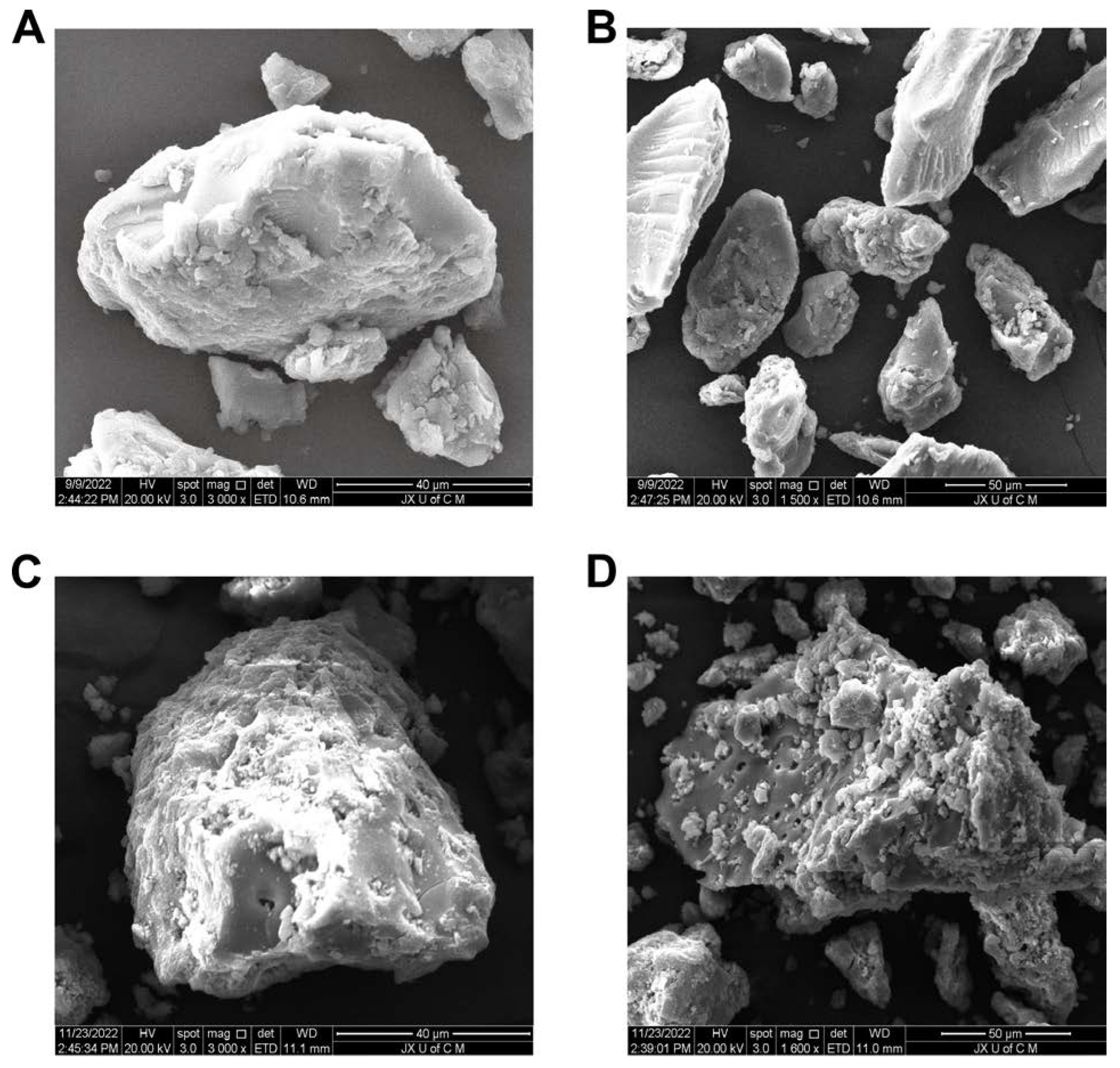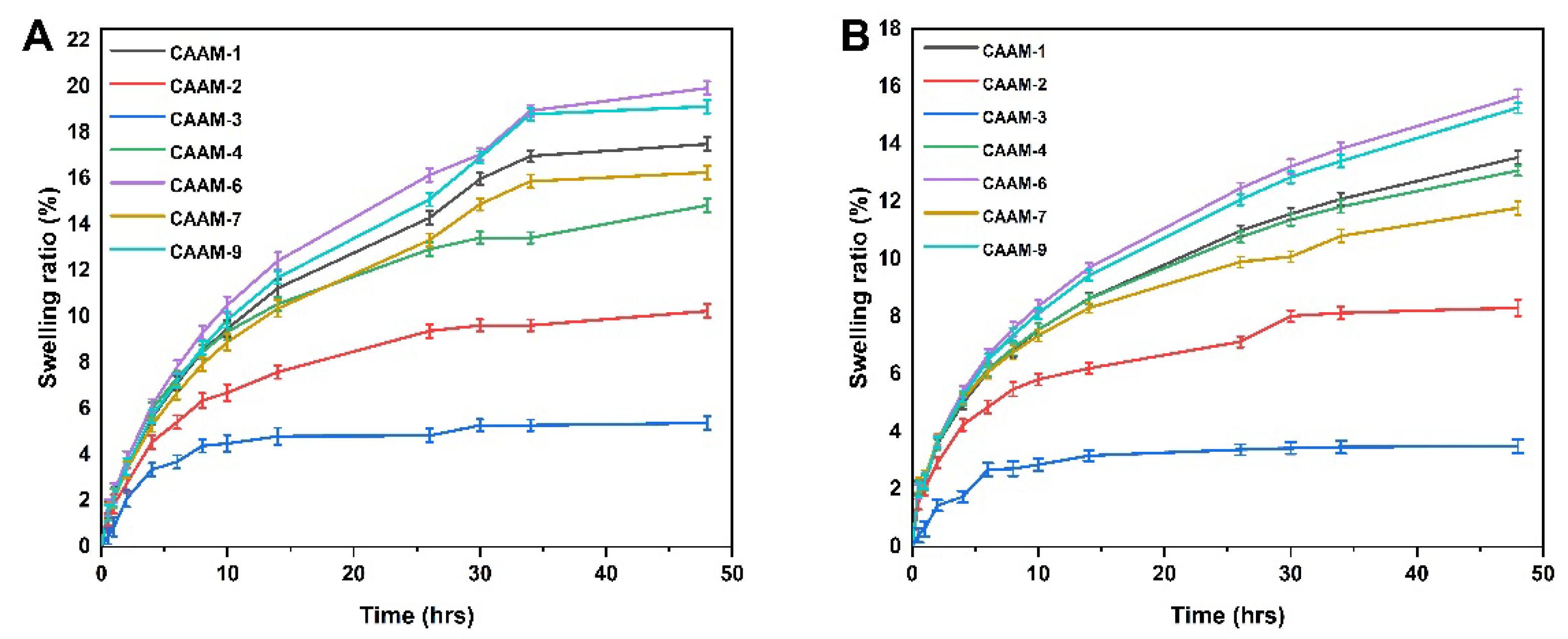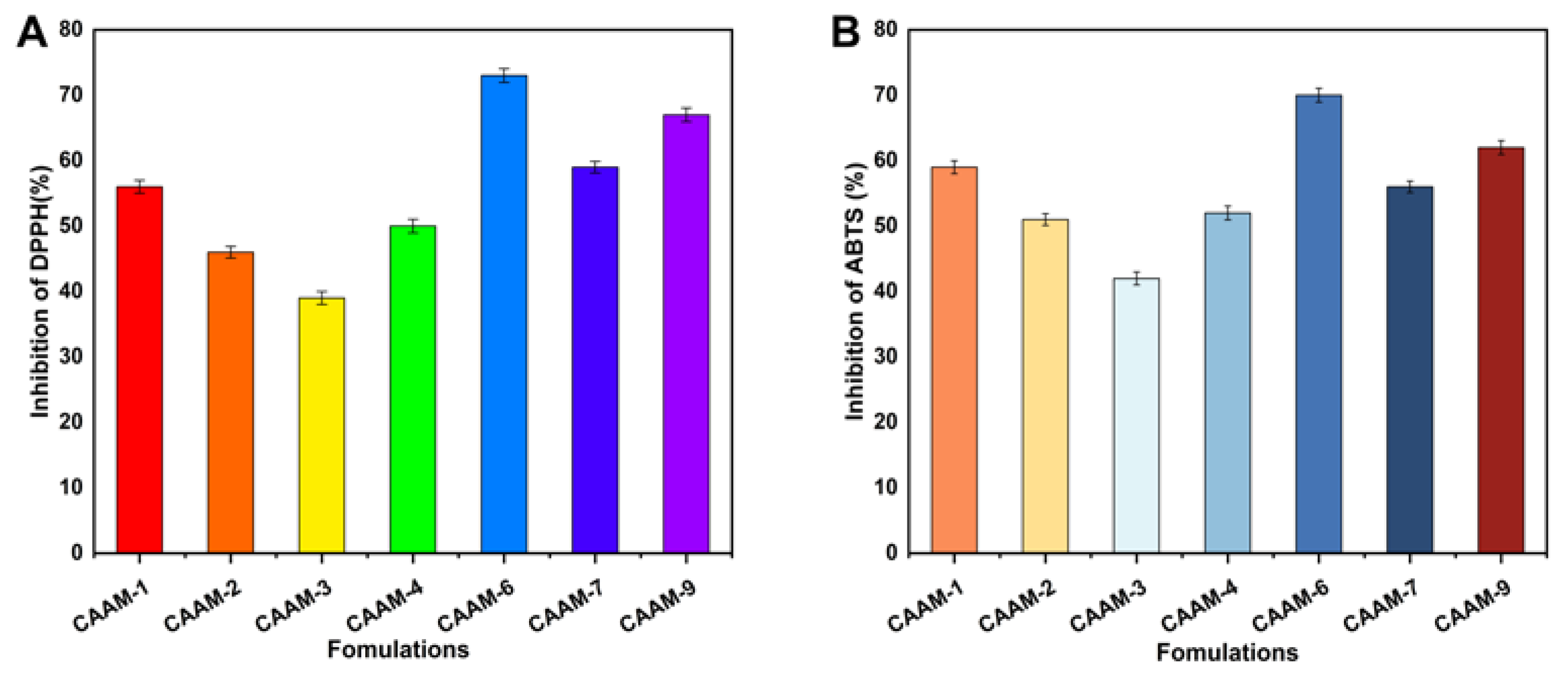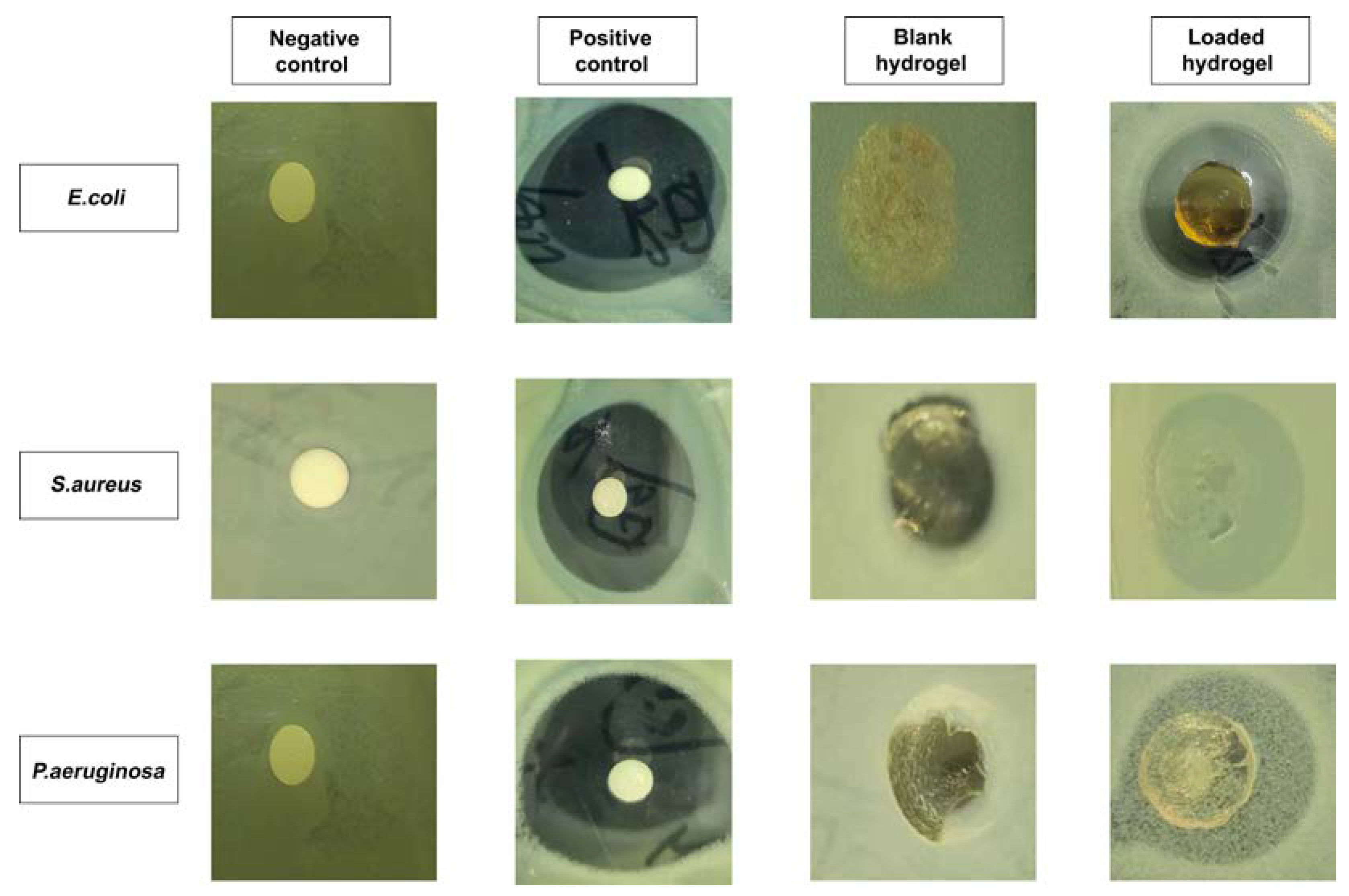Synthesis of Gallic Acid-Loaded Chitosan-Grafted-2-Acrylamido-2-Methylpropane Sulfonic Acid Hydrogels for Oral Controlled Drug Delivery: In Vitro Biodegradation, Antioxidant, and Antibacterial Effects
Abstract
:1. Introduction
2. Results and Discussion
2.1. FTIR Analysis
2.2. TGA and DSC Analysis
2.3. XRD Analysis
2.4. SEM Analysis
2.5. Mechanical Properties Analysis
2.6. Sol–Gel Analysis
2.7. Porosity Study
2.8. Biodegradation Analysis
2.9. Swelling Behavior
2.10. Release and Kinetic Modelling Analysis
2.11. Structural Parameters of CS-g-AMPS Hydrogels
2.12. Antioxidation Analysis
2.13. Antibacterial Study
3. Conclusions
4. Materials and Methods
4.1. Materials
4.2. Synthesis of CS-g-AMPS Hydrogels
4.3. Drug Loading
4.4. In Vitro Characterization
4.4.1. Drug and Hydrogel Compatibility Study
4.4.2. Thermal Stability Study
4.4.3. Determination of Crystallinity
4.4.4. Morphological Analysis
4.4.5. Determination of the Mechanical Properties
4.4.6. Determination of Sol–Gel Fraction
4.4.7. Porosity Study
4.4.8. Biodegradation Study
4.5. CS-g-AMPS Hydrogel Network Parameters
4.5.1. Diffusion Coefficient (D)
4.5.2. Polymer Volume Fraction (V2,s)
4.5.3. Average Molecular Weight between Crosslinks (Mc)
4.5.4. Solvent Interaction Parameters (χ)
4.5.5. Number of Crosslinks between Repeating Units (N)
4.6. Equilibrium Swelling Ratio (ESR)
4.7. In Vitro Drug Release and Kinetics Modeling
4.8. Antioxidant Activities
4.8.1. DPPH Assay
4.8.2. ABTS Assay
4.9. Antibacterial Activity
4.10. Statistical Analysis
Author Contributions
Funding
Institutional Review Board Statement
Informed Consent Statement
Data Availability Statement
Acknowledgments
Conflicts of Interest
References
- Bai, J.; Zhang, Y.; Tang, C.; Hou, Y.; Ai, X.; Chen, X.; Zhang, Y.; Wang, X.; Meng, X. Gallic acid: Pharmacological activities and molecular mechanisms involved in inflammation-related diseases. Biomed. Pharmacother. 2021, 133, 110985. [Google Scholar] [CrossRef] [PubMed]
- Naeem, A.; Ming, Y.; Pengyi, H.; Jie, K.Y.; Yali, L.; Haiyan, Z.; Shuai, X.; Wenjing, L.; Ling, W.; Xia, Z.M. The fate of flavonoids after oral administration: A comprehensive overview of its bioavailability. Crit. Rev. Food Sci. Nutr. 2022, 62, 6169–6186. [Google Scholar] [CrossRef] [PubMed]
- Shukla, S.; Singh, B.; Singh, A.; Singh, C. Emerging and Advanced Drug Delivery Systems for Improved Biopharmaceutical Attributes of Gallic Acid: A Review. Phytomed. Plus 2022, 2, 100369. [Google Scholar] [CrossRef]
- Do, N.H.; Truong, Q.T.; Le, P.K.; Ha, A.C. Recent developments in chitosan hydrogels carrying natural bioactive compounds. Carbohydr. Polym. 2022, 294, 119726. [Google Scholar] [CrossRef] [PubMed]
- Kesharwani, P.; Bisht, A.; Alexander, A.; Dave, V.; Sharma, S. Biomedical applications of hydrogels in drug delivery system: An update. J. Drug Deliv. Sci. Technol. 2021, 66, 102914. [Google Scholar] [CrossRef]
- Jacob, S.; Nair, A.B.; Shah, J.; Sreeharsha, N.; Gupta, S.; Shinu, P. Emerging role of hydrogels in drug delivery systems, tissue engineering and wound management. Pharmaceutics 2021, 13, 357. [Google Scholar] [CrossRef]
- Bernhard, S.; Tibbitt, M.W. Supramolecular engineering of hydrogels for drug delivery. Adv. Drug Deliv. Rev. 2021, 171, 240–256. [Google Scholar] [CrossRef]
- Chatterjee, S.; Hui, P.C.-l. Review of applications and future prospects of stimuli-responsive hydrogel based on thermo-responsive biopolymers in drug delivery systems. Polymers 2021, 13, 2086. [Google Scholar] [CrossRef]
- Lan, W.; Xu, M.; Qin, M.; Cheng, Y.; Zhao, Y.; Huang, D.; Wei, X.; Guo, Y.; Chen, W. Physicochemical properties and biocompatibility of the bi-layer polyvinyl alcohol-based hydrogel for osteochondral tissue engineering. Mater. Des. 2021, 204, 109652. [Google Scholar] [CrossRef]
- Guo, Y.; Fang, Z.; Yu, G. Multifunctional hydrogels for sustainable energy and environment. Polym. Int. 2021, 70, 1425–1432. [Google Scholar] [CrossRef]
- Su, J.; Li, J.; Liang, J.; Zhang, K.; Li, J. Hydrogel preparation methods and biomaterials for wound dressing. Life 2021, 11, 1016. [Google Scholar] [CrossRef] [PubMed]
- Madduma-Bandarage, U.S.; Madihally, S.V. Synthetic hydrogels: Synthesis, novel trends, and applications. J. Appl. Polym. Sci. 2021, 138, 50376. [Google Scholar] [CrossRef]
- Yang, J.; Chen, X.; Zhang, J.; Wang, Y.; Wen, H.; Xie, J. Role of chitosan-based hydrogels in pollutants adsorption and freshwater harvesting: A critical review. Int. J. Biol. Macromol. 2021, 189, 53–64. [Google Scholar] [CrossRef]
- Yang, J.; Shen, M.; Luo, Y.; Wu, T.; Chen, X.; Wang, Y.; Xie, J. Advanced applications of chitosan-based hydrogels: From biosensors to intelligent food packaging system. Trends Food Sci. Technol. 2021, 110, 822–832. [Google Scholar] [CrossRef]
- Krstic, M.; Miladinovic, Z.R.; Barudzija, T.; Mladenovic, A.; Suljovrujic, E. Stimuli-responsive copolymeric hydrogels based on oligo (ethylene glycol) dimethacrylate for biomedical applications: An optimisation study of pH and thermoresponsive behaviour. React. Funct. Polym. 2022, 170, 105140. [Google Scholar] [CrossRef]
- Seo, H.-S.; Bae, J.-Y.; Kwon, K.; Shin, S. Synthesis and assessment of amps-based copolymers prepared via electron-beam irradiation for ionic conductive hydrogels. Polymers 2022, 14, 2547. [Google Scholar] [CrossRef]
- Hu, J.; Dai, H.; Zeng, Y.; Yang, Y.; Wang, H.; Zhu, X.; Li, L.; Zhou, G.; Chen, R.; Guo, L. A cross-linker-based poly (ionic liquid) for sensitive electrochemical detection of 4-nonylphenol. Nanomaterials 2019, 9, 513. [Google Scholar] [CrossRef] [Green Version]
- Malik, N.S.; Ahmad, M.; Minhas, M.U.; Tulain, R.; Barkat, K.; Khalid, I.; Khalid, Q. Chitosan/Xanthan Gum Based Hydrogels as Potential Carrier for an Antiviral Drug: Fabrication, Characterization, and Safety Evaluation. Front. Chem. 2020, 8, 50. [Google Scholar] [CrossRef] [Green Version]
- Ding, Z.; Mo, M.; Zhang, K.; Bi, Y.; Kong, F. Preparation, characterization and biological activity of proanthocyanidin-chitosan nanoparticles. Int. J. Biol. Macromol. 2021, 188, 43–51. [Google Scholar] [CrossRef]
- Hirun, N.; Dokmaisrijan, S.; Tantishaiyakul, V. Experimental FTIR and theoretical studies of gallic acid-acetonitrile clusters. Spectrochim. Acta A Mol. Biomol. Spectrosc. 2012, 86, 93–100. [Google Scholar] [CrossRef]
- Alfei, S.; Marengo, B.; Domenicotti, C. Development of a Fast, Low-Cost, Conservative and Ecological Method for Quantifying Gallic Acid in Polymeric Formulations by FTIR Spectroscopy in Solution. ChemistrySelect 2020, 5, 4381–4388. [Google Scholar] [CrossRef]
- Atta, A.M.; Gafer, A.K.; Al-Lohedan, H.A.; Abdullah, M.M.S.; Tawfeek, A.M.; Ezzat, A.O. Hybrid Ionic Silver and Magnetite Microgels Nanocomposites for Efficient Removal of Methylene Blue. Molecules 2019, 24, 3867. [Google Scholar] [CrossRef] [PubMed] [Green Version]
- Bandara, S.; Carnegie, C.-a.; Johnson, C.; Akindoju, F.; Williams, E.; Swaby, J.M.; Oki, A.; Carson, L.E. Synthesis and characterization of Zinc/Chitosan-Folic acid complex. Heliyon 2018, 4, e00737. [Google Scholar] [CrossRef] [PubMed] [Green Version]
- Teodoro, G.R.; Gontijo, A.V.L.; Borges, A.C.; Tanaka, M.H.; Lima, G.d.M.G.; Salvador, M.J.; Koga-Ito, C.Y. Gallic acid/hydroxypropyl-β-cyclodextrin complex: Improving solubility for application on in vitro/in vivo Candida albicans biofilms. PLoS ONE 2017, 12, e0181199. [Google Scholar] [CrossRef] [Green Version]
- Shoukat, H.; Pervaiz, F.; Noreen, S.; Nawaz, M.; Qaiser, R.; Anwar, M. Fabrication and evaluation studies of novel polyvinylpyrrolidone and 2-acrylamido-2-methylpropane sulphonic acid-based crosslinked matrices for controlled release of acyclovir. Polym. Bull. 2020, 77, 1869–1891. [Google Scholar] [CrossRef]
- Thai, H.; Thuy Nguyen, C.; Thi Thach, L.; Thi Tran, M.; Duc Mai, H.; Thi Thu Nguyen, T.; Duc Le, G.; Van Can, M.; Dai Tran, L.; Long Bach, G. Characterization of chitosan/alginate/lovastatin nanoparticles and investigation of their toxic effects in vitro and in vivo. Sci. Rep. 2020, 10, 909. [Google Scholar] [CrossRef] [Green Version]
- Khanum, H.; Ullah, K.; Murtaza, G.; Khan, S.A. Fabrication and in vitro characterization of HPMC-g-poly (AMPS) hydrogels loaded with loxoprofen sodium. Int. J. Biol. Macromol. 2018, 120, 1624–1631. [Google Scholar] [CrossRef]
- Neo, Y.P.; Ray, S.; Jin, J.; Gizdavic-Nikolaidis, M.; Nieuwoudt, M.K.; Liu, D.; Quek, S.Y. Encapsulation of food grade antioxidant in natural biopolymer by electrospinning technique: A physicochemical study based on zein–gallic acid system. Food Chem. 2013, 136, 1013–1021. [Google Scholar] [CrossRef]
- Paula, H.C.; Silva, R.B.; Santos, C.M.; Dantas, F.D.; de Paula, R.C.; de Lima, L.R.; de Oliveira, E.F.; Figueiredo, E.A.; Dias, F.G. Eco-friendly synthesis of an alkyl chitosan derivative. Int. J. Biol. Macromol. 2020, 163, 1591–1598. [Google Scholar] [CrossRef]
- Ciolacu, D.; Oprea, A.M.; Anghel, N.; Cazacu, G.; Cazacu, M. New cellulose–Lignin hydrogels and their application in controlled release of polyphenols. Mater. Sci. Eng. C 2012, 32, 452–463. [Google Scholar] [CrossRef]
- Park, D.W.; Haam, S.; Lee, T.G.; Kim, H.S.; Kim, W.S. Chemoenzymatic synthesis of sugar-containing biocompatible hydrogels: Crosslinked poly (β-methylglucoside acrylate) and poly (β-methylglucoside methacrylate). J. Biomed. Mater. Res. Part A Off. J. Soc. Biomater. Jpn. Soc. Biomater. Aust. Soc. Biomater. Korean Soc. Biomater. 2004, 71, 497–507. [Google Scholar] [CrossRef] [PubMed]
- Liu, C.; Tripathi, A.K.; Gao, W.; Tsavalas, J.G. Crosslinking in Semi-Batch Seeded Emulsion Polymerization: Effect of Linear and Non-Linear Monomer Feeding Rate Profiles on Gel Formation. Polymers 2021, 13, 596. [Google Scholar] [CrossRef] [PubMed]
- Suflet, D.M.; Popescu, I.; Pelin, I.M.; Ichim, D.L.; Daraba, O.M.; Constantin, M.; Fundueanu, G. Dual cross-linked chitosan/pva hydrogels containing silver nanoparticles with antimicrobial properties. Pharmaceutics 2021, 13, 1461. [Google Scholar] [CrossRef] [PubMed]
- de Farias, B.S.; Junior, T.R.S.A.C.; de Almeida Pinto, L.A. Chitosan-functionalized nanofibers: A comprehensive review on challenges and prospects for food applications. Int. J. Biol. Macromol. 2019, 123, 210–220. [Google Scholar] [CrossRef] [PubMed]
- Alven, S.; Aderibigbe, B.A. Fabrication of Hybrid Nanofibers from Biopolymers and Poly (Vinyl Alcohol)/Poly (ε-Caprolactone) for Wound Dressing Applications. Polymers 2021, 13, 2104. [Google Scholar] [CrossRef]
- Richbourg, N.; Wancura, M.; Gilchrist, A.; Toubbeh, S.; Harley, B.; Cosgriff-Hernandez, E.; Peppas, N. Precise control of synthetic hydrogel network structure via linear, independent synthesis-swelling relationships. Sci. Adv. 2021, 7, eabe3245. [Google Scholar] [CrossRef]
- Karoyo, A.H.; Wilson, L.D. A review on the design and hydration properties of natural polymer-based hydrogels. Materials 2021, 14, 1095. [Google Scholar] [CrossRef]
- Ashames, A.; Pervaiz, F.; Al-Tabakha, M.; Khalid, K.; Hassan, N.; Shoukat, H.; Buabeid, M.; Murtaza, G. Synthesis of cross-linked carboxymethyl cellulose and poly (2-acrylamido-2-methylpropane sulfonic acid) hydrogel for sustained drug release optimized by Box-Behnken Design. J. Saudi Chem. Soc. 2022, 26, 101541. [Google Scholar] [CrossRef]
- Li, D.-q.; Wang, S.-y.; Meng, Y.-j.; Guo, Z.-w.; Cheng, M.-m.; Li, J. Fabrication of self-healing pectin/chitosan hybrid hydrogel via Diels-Alder reactions for drug delivery with high swelling property, pH-responsiveness, and cytocompatibility. Carbohydr. Polym. 2021, 268, 118244. [Google Scholar] [CrossRef]
- Khan, M.U.A.; Yaqoob, Z.; Ansari, M.N.M.; Razak, S.I.A.; Raza, M.A.; Sajjad, A.; Haider, S.; Busra, F.M. Chitosan/poly vinyl alcohol/graphene oxide based pH-responsive composite hydrogel films: Drug release, anti-microbial and cell viability studies. Polymers 2021, 13, 3124. [Google Scholar] [CrossRef]
- Li, Y.; Wang, C.; Luan, Y.; Liu, W.; Chen, T.; Liu, P.; Liu, Z. Preparation of pH-responsive cellulose nanofibril/sodium alginate based hydrogels for drug release. J. Appl. Polym. Sci. 2022, 139, 51647. [Google Scholar] [CrossRef]
- Jalil, A.; Khan, S.; Naeem, F.; Haider, M.S.; Sarwar, S.; Riaz, A.; Ranjha, N.M. The structural, morphological and thermal properties of grafted pH-sensitive interpenetrating highly porous polymeric composites of sodium alginate/acrylic acid copolymers for controlled delivery of diclofenac potassium. Des. Monomers Polym. 2017, 20, 308–324. [Google Scholar] [CrossRef] [PubMed] [Green Version]
- Choubey, S.; Goyal, S.; Varughese, L.R.; Kumar, V.; Sharma, A.K.; Beniwal, V. Probing gallic acid for its broad spectrum applications. Mini Rev. Med. Chem. 2018, 18, 1283–1293. [Google Scholar] [CrossRef] [PubMed]
- Yayan, J.; Ghebremedhin, B.; Rasche, K. Cefepime shows good efficacy and no antibiotic resistance in pneumonia caused by Serratia marcescens and Proteus mirabilis—An observational study. BMC Pharmacol. Toxicol. 2016, 17, 10. [Google Scholar] [CrossRef] [PubMed] [Green Version]
- Kamaci, M.; Kaya, I. Melamine-based poly (azomethine) hydrogels: Mechanical, biodegradability, drug loading and antibacterial properties. Eur. Polym. J. 2018, 108, 107–115. [Google Scholar] [CrossRef]
- Joshi, P.; Ahmed, M.S.U.; Vig, K.; Vega Erramuspe, I.B.; Auad, M.L. Synthesis and characterization of chemically crosslinked gelatin and chitosan to produce hydrogels for biomedical applications. Polym. Adv. Technol. 2021, 32, 2229–2239. [Google Scholar] [CrossRef]
- Guan, Y.; Yu, C.; Zang, Z.; Wan, X.; Naeem, A.; Zhang, R.; Zhu, W. Chitosan/xanthan gum-based (Hydroxypropyl methylcellulose-co-2-Acrylamido-2-methylpropane sulfonic acid) interpenetrating hydrogels for controlled release of amorphous solid dispersion of bioactive constituents of Pueraria lobatae. Int. J. Biol. Macromol. 2022; in press. [Google Scholar] [CrossRef]
- Zang, Z.; Zhao, S.; Yang, M.; Yu, C.; Ouyang, H.; Chen, L.; Zhu, W.; Liao, Z.-g.; Naeem, A.; Guan, Y. Blood chemical components analysis of honeysuckle and formulation of xanthan gum/starch-based (PVA-co-AA) hydrogels for controlled release. Arab. J. Chem. 2022, 15, 104312. [Google Scholar] [CrossRef]
- Li, Z.; Jiang, X.; Huang, H.; Liu, A.; Liu, H.; Abid, N.; Ming, L. Chitosan/zein films incorporated with essential oil nanoparticles and nanoemulsions: Similarities and differences. Int. J. Biol. Macromol. 2022, 208, 983–994. [Google Scholar] [CrossRef]
- Hao, X.; Sun, X.; Zhu, H.; Xie, L.; Wang, X.; Jiang, N.; Fu, P.; Sang, M. Hydroxypropyl-β-Cyclodextrin-Complexed Resveratrol Enhanced Antitumor Activity in a Cervical Cancer Model: In Vivo Analysis. Front. Pharmacol. 2021, 12, 665. [Google Scholar] [CrossRef]
- Suhail, M.; Hsieh, Y.-H.; Shao, Y.-F.; Minhas, M.U.; Wu, P.-C. Formulation and In-Vitro Characterization of pH-Responsive Semi-Interpenetrating Polymer Network Hydrogels for Controlled Release of Ketorolac Tromethamine. Gels 2021, 7, 167. [Google Scholar] [CrossRef] [PubMed]
- Xu, Z.; Liu, G.; Li, Q.; Wu, J. A novel hydrogel with glucose-responsive hyperglycemia regulation and antioxidant activity for enhanced diabetic wound repair. Nano Res. 2022, 15, 5305–5315. [Google Scholar] [CrossRef]
- Lorz, L.R.; Yoo, B.C.; Kim, M.-Y.; Cho, J.Y. Anti-wrinkling and anti-melanogenic effect of Pradosia mutisii methanol extract. Int. J. Mol. Sci. 2019, 20, 1043. [Google Scholar] [CrossRef] [PubMed] [Green Version]
- Abbasi, A.R.; Sohail, M.; Minhas, M.U.; Khaliq, T.; Kousar, M.; Khan, S.; Hussain, Z.; Munir, A. Bioinspired sodium alginate based thermosensitive hydrogel membranes for accelerated wound healing. Int. J. Biol. Macromol. 2020, 155, 751–765. [Google Scholar] [CrossRef] [PubMed]









| Formulation Codes | Thickness (mm) | TS (N/mm) | EAB (%) | Drug Loaded per 1 g Hydrogel (g) |
|---|---|---|---|---|
| CAAM-1 | 0.99 | 0.439 | 43.9 | 0.479 |
| CAAM-2 | 1.05 | 0.796 | 61.5 | 0.339 |
| CAAM-3 | 1.24 | 0.842 | 69.3 | 0.310 |
| CAAM-4 | 1.19 | 0.421 | 41.0 | 0.412 |
| CAAM-5 | 0.99 | 0.439 | 43.9 | 0.479 |
| CAAM-6 | 1.36 | 0.958 | 72.5 | 0.514 |
| CAAM-7 | 1.59 | 0.443 | 51.3 | 0.396 |
| CAAM-8 | 0.99 | 0.439 | 43.9 | 0.479 |
| CAAM-9 | 0.98 | 0.802 | 66.2 | 0.456 |
| F. Codes | pH | Zero Order | First Order | Higuchi Model | Korsmeyer–Peppas Model | ||||
|---|---|---|---|---|---|---|---|---|---|
| Ko (h−1) | r2 | K1 (h−1) | r2 | K2 (h−1) | r2 | r2 | n | ||
| CAAM-1 | 1.2 | 0.594 | 0.9368 | 0.010 | 0.9603 | 3.461 | 0.9958 | 0.9969 | 0.444 |
| 7.4 | 0.591 | 0.9578 | 0.007 | 0.9488 | 3.514 | 0.9919 | 0.9980 | 0.390 | |
| CAAM-2 | 1.2 | 0.387 | 0.8795 | 0.004 | 0.8902 | 2.310 | 0.9730 | 0.9872 | 0.324 |
| 7.4 | 0.314 | 0.8631 | 0.003 | 0.8716 | 1.898 | 0.9649 | 0.9888 | 0.270 | |
| CAAM-3 | 1.2 | 0.199 | 0.7639 | 0.002 | 0.7703 | 1.229 | 0.9009 | 0.9461 | 0.240 |
| 7.4 | 0.137 | 0.7773 | 0.001 | 0.7817 | 0.849 | 0.9112 | 0.9475 | 0.220 | |
| CAAM-4 | 1.2 | 0.424 | 0.8959 | 0.005 | 0.9067 | 2.504 | 0.9804 | 0.9909 | 0.353 |
| 7.4 | 0.341 | 0.8969 | 0.004 | 0.9044 | 2.034 | 0.9793 | 0.9928 | 0.305 | |
| CAAM-5 | 1.2 | 0.594 | 0.9368 | 0.010 | 0.9603 | 3.461 | 0.9958 | 0.9969 | 0.444 |
| 7.4 | 0.591 | 0.9578 | 0.007 | 0.9488 | 3.514 | 0.9919 | 0.9980 | 0.390 | |
| CAAM-6 | 1.2 | 0.811 | 0.9377 | 0.010 | 0.9551 | 4.685 | 0.9945 | 0.9959 | 0.432 |
| 7.4 | 0.667 | 0.9380 | 0.008 | 0.9514 | 3.888 | 0.9961 | 0.9980 | 0.386 | |
| CAAM-7 | 1.2 | 0.721 | 0.9306 | 0.009 | 0.9465 | 4.195 | 0.9928 | 0.9953 | 0.405 |
| 7.4 | 0.507 | 0.9196 | 0.006 | 0.9309 | 2.987 | 0.9906 | 0.9967 | 0.346 | |
| CAAM-8 | 1.2 | 0.594 | 0.9368 | 0.010 | 0.9603 | 3.461 | 0.9958 | 0.9969 | 0.444 |
| 7.4 | 0.591 | 0.9578 | 0.007 | 0.9488 | 3.514 | 0.9919 | 0.9980 | 0.390 | |
| CAAM-9 | 1.2 | 0.625 | 0.9313 | 0.007 | 0.9449 | 3.630 | 0.9928 | 0.9951 | 0.413 |
| 7.4 | 0.502 | 0.9291 | 0.006 | 0.9396 | 2.943 | 0.9937 | 0.9976 | 0.360 | |
| F. Codes | V2,s | χ | Mc | Mr | N | D × 10−5 (cm2 s−1) |
|---|---|---|---|---|---|---|
| CAAM-1 | 0.032 | 0.510 | 3013.6 | 238.10 | 25.313 | 0.022 |
| CAAM-2 | 0.076 | 0.526 | 2860.0 | 237.21 | 24.113 | 0.015 |
| CAAM-3 | 0.157 | 0.559 | 1364.1 | 236.33 | 11.544 | 0.049 |
| CAAM-4 | 0.067 | 0.523 | 1082.3 | 257.32 | 8.412 | 0.052 |
| CAAM-5 | 0.032 | 0.510 | 3013.6 | 238.10 | 25.313 | 0.022 |
| CAAM-6 | 0.033 | 0.511 | 3289.4 | 229.53 | 28.662 | 0.061 |
| CAAM-7 | 0.037 | 0.512 | 1247.3 | 203.82 | 12.239 | 0.055 |
| CAAM-8 | 0.032 | 0.510 | 3013.6 | 238.10 | 25.313 | 0.022 |
| CAAM-9 | 0.043 | 0.514 | 5333.3 | 250.33 | 42.610 | 0.048 |
| Formulation Codes | Chitosan (g) | AMPS (g) | APS/SHS (g) | EGDMA (g) |
|---|---|---|---|---|
| CAAM-1 | 0.5 | 20 | 0.3/0.3 | 0.5 |
| CAAM-2 | 0.5 | 20 | 0.3/0.3 | 1 |
| CAAM-3 | 0.5 | 20 | 0.3/0.3 | 1.5 |
| CAAM-4 | 0.5 | 12 | 0.3/0.3 | 0.5 |
| CAAM-5 | 0.5 | 20 | 0.3/0.3 | 0.5 |
| CAAM-6 | 0.5 | 28 | 0.3/0.3 | 0.5 |
| CAAM-7 | 0.3 | 20 | 0.3/0.3 | 0.5 |
| CAAM-8 | 0.5 | 20 | 0.3/0.3 | 0.5 |
| CAAM-9 | 0.7 | 20 | 0.3/0.3 | 0.5 |
Publisher’s Note: MDPI stays neutral with regard to jurisdictional claims in published maps and institutional affiliations. |
© 2022 by the authors. Licensee MDPI, Basel, Switzerland. This article is an open access article distributed under the terms and conditions of the Creative Commons Attribution (CC BY) license (https://creativecommons.org/licenses/by/4.0/).
Share and Cite
Yu, C.; Chen, X.; Zhu, W.; Li, L.; Peng, M.; Zhong, Y.; Naeem, A.; Zang, Z.; Guan, Y. Synthesis of Gallic Acid-Loaded Chitosan-Grafted-2-Acrylamido-2-Methylpropane Sulfonic Acid Hydrogels for Oral Controlled Drug Delivery: In Vitro Biodegradation, Antioxidant, and Antibacterial Effects. Gels 2022, 8, 806. https://doi.org/10.3390/gels8120806
Yu C, Chen X, Zhu W, Li L, Peng M, Zhong Y, Naeem A, Zang Z, Guan Y. Synthesis of Gallic Acid-Loaded Chitosan-Grafted-2-Acrylamido-2-Methylpropane Sulfonic Acid Hydrogels for Oral Controlled Drug Delivery: In Vitro Biodegradation, Antioxidant, and Antibacterial Effects. Gels. 2022; 8(12):806. https://doi.org/10.3390/gels8120806
Chicago/Turabian StyleYu, Chengqun, Xuanbin Chen, Weifeng Zhu, Lijun Li, Mingyan Peng, Yulian Zhong, Abid Naeem, Zhenzhong Zang, and Yongmei Guan. 2022. "Synthesis of Gallic Acid-Loaded Chitosan-Grafted-2-Acrylamido-2-Methylpropane Sulfonic Acid Hydrogels for Oral Controlled Drug Delivery: In Vitro Biodegradation, Antioxidant, and Antibacterial Effects" Gels 8, no. 12: 806. https://doi.org/10.3390/gels8120806





